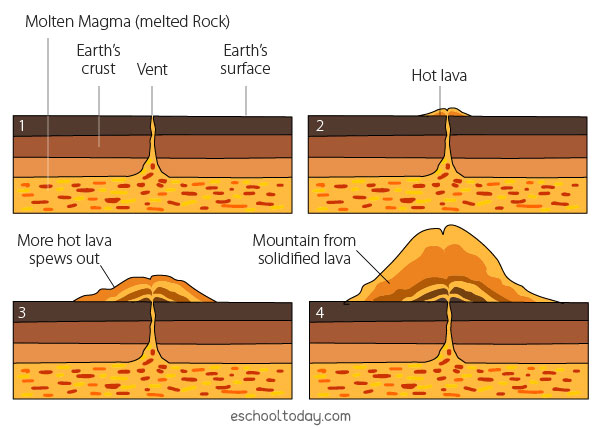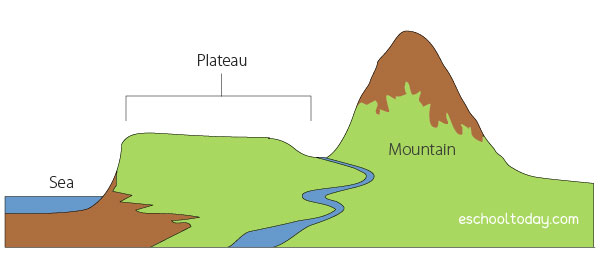- Landforms
Landforms formed from Volcanic Eruptions
Volcanic activity is another constructive factor in the formation of landforms. Volcanic action involves the release of molten magma (melted rock) from deep below the earth’s surface. When molten magma is spewed onto the earth’s surface, it is called lava. When lava cools off on the earth’s surface, they solidify and may form land features. This action is responsible for the formations of many spectacular landforms. Some examples of landforms created by volcanic activity include lava domes, plateaux, and calderas.
It is key to know the relationship between volcanoes and mountains. A volcano is only a vent (hole in the earth’s crust) through which lava spews out. It means a volcano alone is not a mountain. It becomes a mountain when the spewed out lava solidifies around the vent to form a hard, rocky mound around the vent.

Landforms formed from the volcanic activity will depend on the kind of volcano it is or the material produced.
Here are a few important examples of landforms from volcanic eruptions
Shield Volcanoes:
They form by non-explosive eruptions of low viscosity (more fluid lava) lava. The features of this kind of volcano are its gentle upper slopes and steep lower slopes. Low viscosity material from the vent spreads around quickly before they cool and solidify. As they cool, viscosity increases, causing it to thicken at the edges.
Craters and Calderas:
These are circular depressions that collect rainwater or snowmelt and are created by very explosive and gaseous eruptions. They are formed by a collapse of a volcanic structure. Craters are smaller in size (less than 1km in diameter), and Calderas are larger (between 1km–50km). Examples include Yellowstone Caldera in Wyoming, Long Valley Caldera in eastern California, and Valles Caldera in New Mexico.
Plateau:

A plateau is an elevated portion of the land with a flat surface. It often has steep slopes or cliffs at one or more sides. It is nicknamed tableland because it looks like a table. They are very common and believed to cover a third of the total land area of planet earth. Plateaux are formed in many ways. One way is when volcanoes erupt small amounts of lava over a long period. The lava is usually low in viscosity, and so it easily spreads over a long distance before they harden.
Our research for this topic included these sources:
1. Volcanic Landforms, Volcanoes and Plate Tectonics, Prof. Stephen A. Nelson
www.tulane.edu/~sanelson/Natural_Disasters/volclandforms.htm
2. Dunn, Margery G. (Editor). (1989, 1993). “Exploring Your World: The Adventure of Geography.” Washington, D.C.: National Geographic Society. www.nationalgeographic.org/encyclopedia/plateau/
